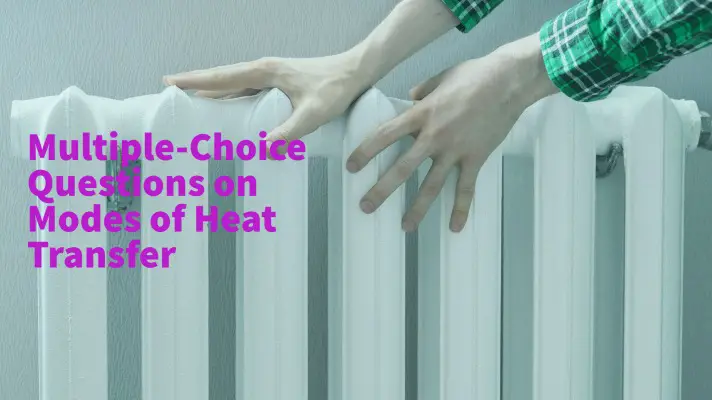Hello students! In this article, I will display Multiple-Choice Questions on Modes of Heat Transfer for Mechanical Engineering Students. Here is the good news for you that I will explain each chapter of Mechanical Engineering in an easy way so that you can take preparation for the Gate Examination.
Sometimes, things are making us confused. To avoid that confusion if there exist some tricks, I will share those tricks here too. The purpose is to clear your concept and that also by studying and answering some objective type questions or short questions.
Whenever new questions will flash in my mind, I will modify the article and therefore it is my request to you to be updated.
Now, let me start the MCQ Questions on Modes of Heat Transfer.

Multiple-Choice Questions on Modes of Heat Transfer
- Which one of the following materials will have a maximum temperature drop for a given heat flow when they have the same thickness?
- Copper
- Glass wool
- Steel
- Refractory brick
Ans: (2) According to Fourier’s law of heat conduction, Q= KA dT/dX
QdX/A = KdT =constant.
Hence, dT α 1/K
The temperature drop will be maximum for glass wool as K is the lowest in this case.
- A steel ball of mass 1 kg and specific heat 0.4 kJ/kg is at a temperature of 600C. The ball is dropped into 1 kg water at 200C. The final steady state temperature of water is:
- 230C
- 300C
- 350C
- 400C
Ans: Qin=Qout
=> 1*0.4*(60-X)=1*4.2*(X-20)
=> 4(60-X)=42(X-20)
=> 240-4X=42X-840
=> 46X=1060
=> X=23 (approx)
- Arrange the following materials in descending order of thermal conductivity.
(a) Pure iron, (b) Water, (c) Saturated water vapour, (d) Pure Aluminium
- bcad
2. dabc
3. abcd
4. dcba
Ans: (2) dabc
- Two identical blocks of copper and air mass are subjected to a symmetrical heat transfer from one face of each block. How will be the rate of heat transfer within the blocks?
- Faster in copper block
- Faster in air mass block
- Equal in both the blocks
- Can’t be predicted due to lack of data.
Ans: (1)
- The Fourier heat conduction equation Q=-kAdT/dX presumes:
- Steady-state condition
2. The constant value of thermal conductivity
3. One-dimensional heat flow
4. Uniform temperatures at the wall surfaces
- 1,2,3
2. 2,3,4
3. 1,3,4
4. 1,2,4
Ans: (3)
- A plane wall of 25 cm thickness is having an area of 1m2. The thermal conductivity of the wall material is 0.5 W/m.K. If there exists a temperature difference of 60K across the wall, find out the value of heat flow?
- 120 W
- 140W
- 160W
- 180W
Ans: (1)
dT = 60K
K = 0.5 W/m.K
dX= 0.25m, A= 1 m2
Q=0.5*1*60/0.25= 120 Watt
- The thermal conductivity of air and water at 300C are:
- 0.026, 0.58 W/m.K
- 0.026,0.85 W.m/K
- 0.62,0.85 W/m.k
- 0.62, 0.58 W.m/K
Ans: (1)
- A large concrete slab 1m thick has one dimensional temperature distribution:
T = 4-10x+50x2+50x3
Where, T= temperature, x= the distance from one face to the other face of the wall. The thermal diffusivity of the wall material is 2×10-3 m2/hr. find out the rate of change of temperature on the other facet of the wall.
- 0.2 0C/hr
- 0.4 0C/hr
- 0.6 0C/hr
- 0.8 0C/hr
Ans: (4) Q/A = rate of change of heat transfer = K.dT/dX
∂T/∂X= -10+100x+150x2
∂2T/∂X2= 100+300x=100+300*1=400
∂2T/∂X2= (1/α)*( ∂T/∂t)
∂T/∂t = α ∂2T/∂X2= 2*10-3*400=800/1000=4/5=0.80C
- Thermal diffusivity of a material can be formulated as:
- ρCp/K
- K/ ρCp
- ρ/KCp
- Kρ/ Cp
Ans: (2)
- The thermal diffusivity of a substance is :
- Directly proportional to the thermal conductivity.
- Inversely proportional to the thermal conductivity
- Directly proportional to the square of thermal conductivity
- Inversely proportional to the cube of thermal conductivity.
Ans: (1)
- In the M-L-T-Q system, the dimension of the thermal diffusivity is:
- ML2T-1
- M-1L2T-1
- L2T-1
- ML2T-2
Ans: (3)
- Match the following:
A. Schimdt number
B. Lewis Number
C. Thermal Diffusivity
D. Sherwood Number
- K/ (ρCp)
- K/ (ρCpD)
- hmL/D
- μ/ρD
- A1,B2,C3,D4
2. A2,B3,C1,D4
3. A3,B2,C1,D4
4. A4,B2,C1,D3
Ans: (4) Schmidt number= Viscous diffusion rate/Mass diffusion rate; Lewis number = Thermal diffusivity/ Mass diffusivity; Sherwood number = Mass transfer by convection/Mass transfer by diffusion
Short Questions on Modes of Heat Transfer
How the energy is stored inside a molecule of a substance?
Ans: Energy is stored in the following two forms:
Internal Energy and Kinetic energy of molecules.
The kinetic energy of a molecule is the sum of Translational energy, Rotational energy, and Vibrational energy.
The internal energy of a molecule can be of fully kinetic energy or of full potential energy or a mixture of kinetic energy and potential energy.
State Fourier’s law of heat conduction.
Ans: The conducted heat is always proportional to the temperature gradient and the concerned surface area through which heat is conducted.
QαA ; also Qα(dt/dx)
Combining the above two equations, QαA dt/dx
Q= K.A.dt/dx
Here, K is the Proportional constant. K is the Thermal Conductivity of the substance.
The temperature gradient is always negative along the positive x-direction.
State some features of Fourier’s law.
Ans: The features of Fourier’s law are as follows:
Fourier’s law is obtained from an experiment. It can’t be obtained from the thermodynamics laws.
We can apply this law to all substances such as solid, liquid, and gas.
It indicates that the heat flow rate is in the direction of decreasing temperature.
What is an Isotherm?
Ans: In a process, there may exist different states of equal temperature. If you join these states points, the arrival curve you will get is an Isotherm.
What is the unit of thermal conductivity?
Ans: The unit of thermal conductivity is Watt/m.K
List the thermal conductivity of some materials like copper,gold,steel,aluminium,silver,saw dust,glass wool.
Ans: Thermal conductivities of some materials:
| Sl No. | Materials | Thermal Conductivity(W/m.K) |
| 1. | Pure Copper | 385 |
| 2. | Gold | 315 |
| 3. | Steel | 40 |
| 4. | Aluminum | 25 |
| 5. | Silver | 10 |
| 6. | Sawdust | 0.07 |
| 7. | Glass wool | 0.03 |
Arrange the following substances in ascending order of thermal conductivity: liquid,solid,gas.
Ans: gas<liquid<solid
How does the thermal conductivity vary with temperature for solid, liquid and gas?
Ans: K=k0(1+βt) where t is temperature, k is thermal conductivity and k0 is the thermal conductivity at zero temperature.
For solid metals and liquids: β is negative (except Al, U, and water)
So, when t increases, k decreases.
For gases, non-metals, and insulating materials β is positive.
So, when t increases, k increases.
What are the parameters that affect the thermal conductivity?
Ans: The parameters that affect the thermal conductivity are as follows:
Chemical composition: pure metals have a higher thermal conductivity than that of alloying elements.
Mechanical formation: different states like forging, drawing, annealing, bending have different thermal conductivities.
Temperature: The value of K decreases at an elevated temperature for the metals.
Presence of air: the presence of air in the pores reduces the thermal conductivity.
Dampness: thermal conductivity of a damped material is higher than that of the normal material.
Density: When density increases, thermal conductivity also increases.
State an equation and indicate on which parameters the thermal conductivity of liquid depends.
Ans: k=3δ(Vs/λ2); δ- Boltzmann constant per molecule=R/As
Vs– Sonic velocity of molecules; λ- the distance between two adjacent molecules;
R- Universal gas constant; As– Avogadro’s number
State an equation and indicate on which parameters the thermal conductivity of gas depends.
Ans: k = 1/6(nVsf δ λ)
Where n=number of molecules per unit volume
f= number of degrees of freedom
Vs– Arithmetic mean velocity of molecules; λ- the distance between two adjacent molecules or molecular mean free path.
The thermal conductivity of fluid depends on the viscosity too and the equation is:
K=[1+4.5/2n]μCv where μ – dynamic viscosity, n = number of atoms in a molecule.
State Wiedmann and Franz Law.
Ans: [k/(vT)]=C
K= Thermal conductivity at T(K)
V= Electrical conductivity at T(K)
C=Lorenz number = 2.45x 10-8 wα/k2
This law states that the metals that are good conductors of electricity are also good conductors of heat. Mica is the exception.
Write down the thermal resistances of slab, hollow cylinder and hollow sphere; convective thermal resistance and radioactive thermal resistance.
Ans: Rslab= L/K.A
Rhollow cylinder= ln(r2-r1)/(K.2πl)
Rhollow sphere= (r2-r1)/(K.4π r1 r2)
Rconvective=(1/h.A)
R radiation thermal resistance =1/[FαA(T1+T2)(T12+T22)]
Write down the expression of Thermal Resistance of a sphere.
Ans: Rth= (1/ r1-1/ r2)/4πk
What is Isotropic and anisotropic material?
Ans: When the material properties vary along with the direction of the materials, it is known as an anisotropic material. When the material properties don’t change with respect to the directions of the material, it is known as an anisotropic material.
What is thermal diffusivity?
Ans: Thermal diffusivity (α) is the ratio of thermal conductivity (k) and thermal capacity. It is the rate of diffusion of heat. Unit of thermal diffusivity is m2/sec.
Thermal capacity is the product of density and heat capacity i.e. ρcp.
Hence, α=(k/ ρcp)
Conclusion
I hope that you like the Multiple-choice Questions on Modes of Heat Transfer along with the short questions. The definitions of basic modes of heat transfer- conduction, convection, and radiation have not been discussed here as you have already studied those in your school. Wish you all good luck for your upcoming GATE Examination. Best Wishes!


